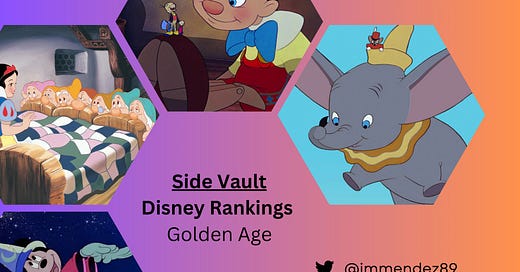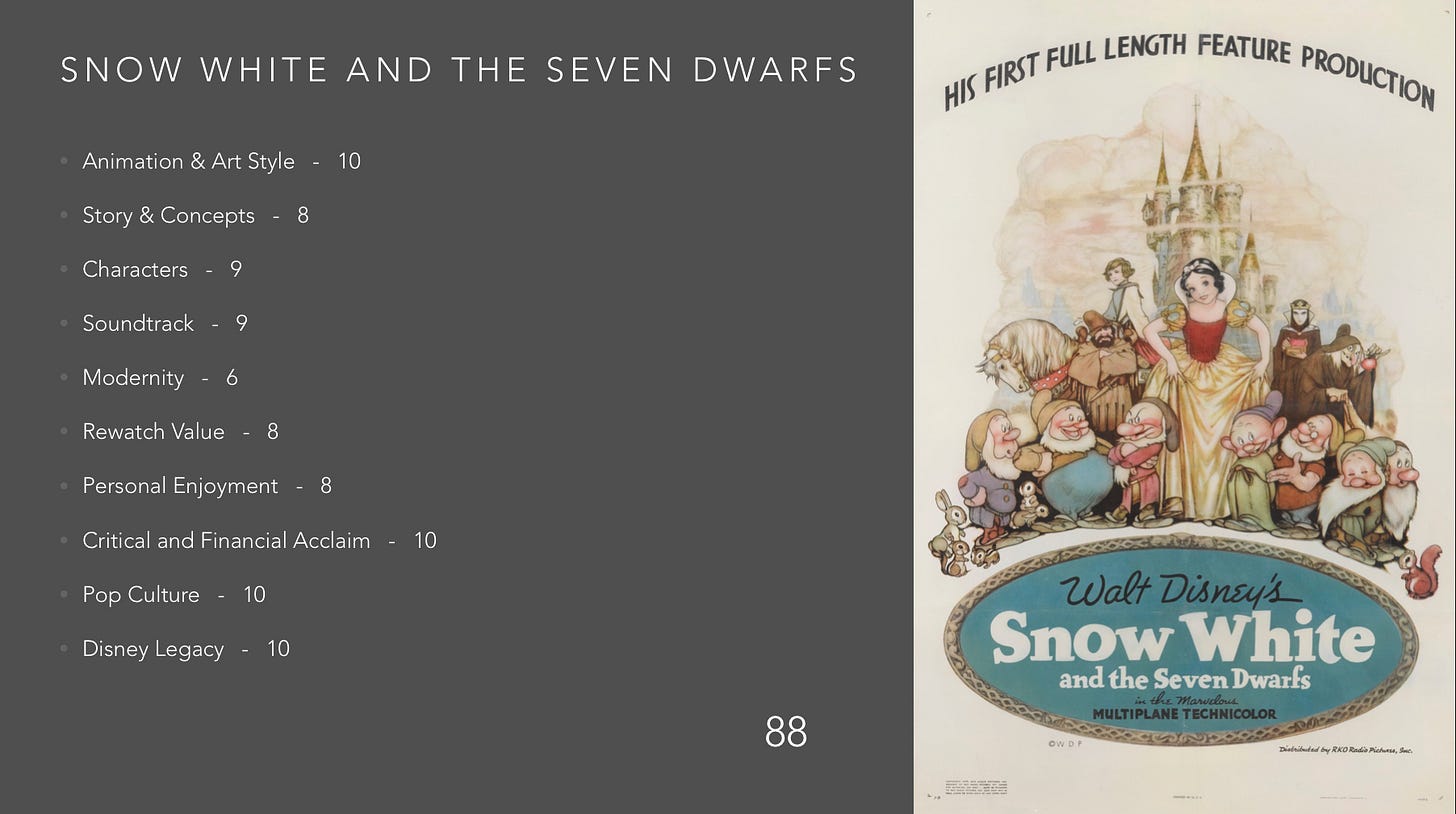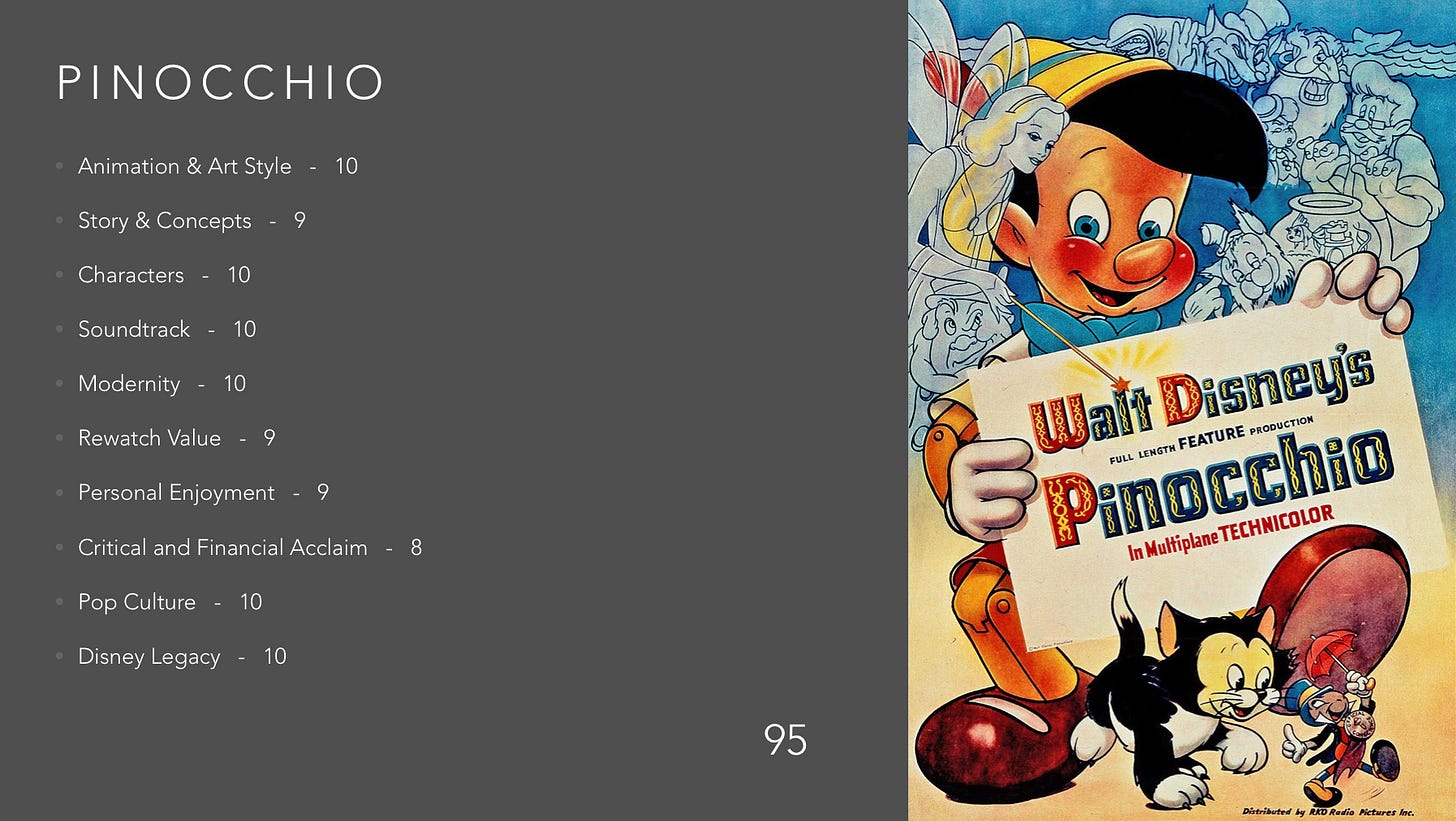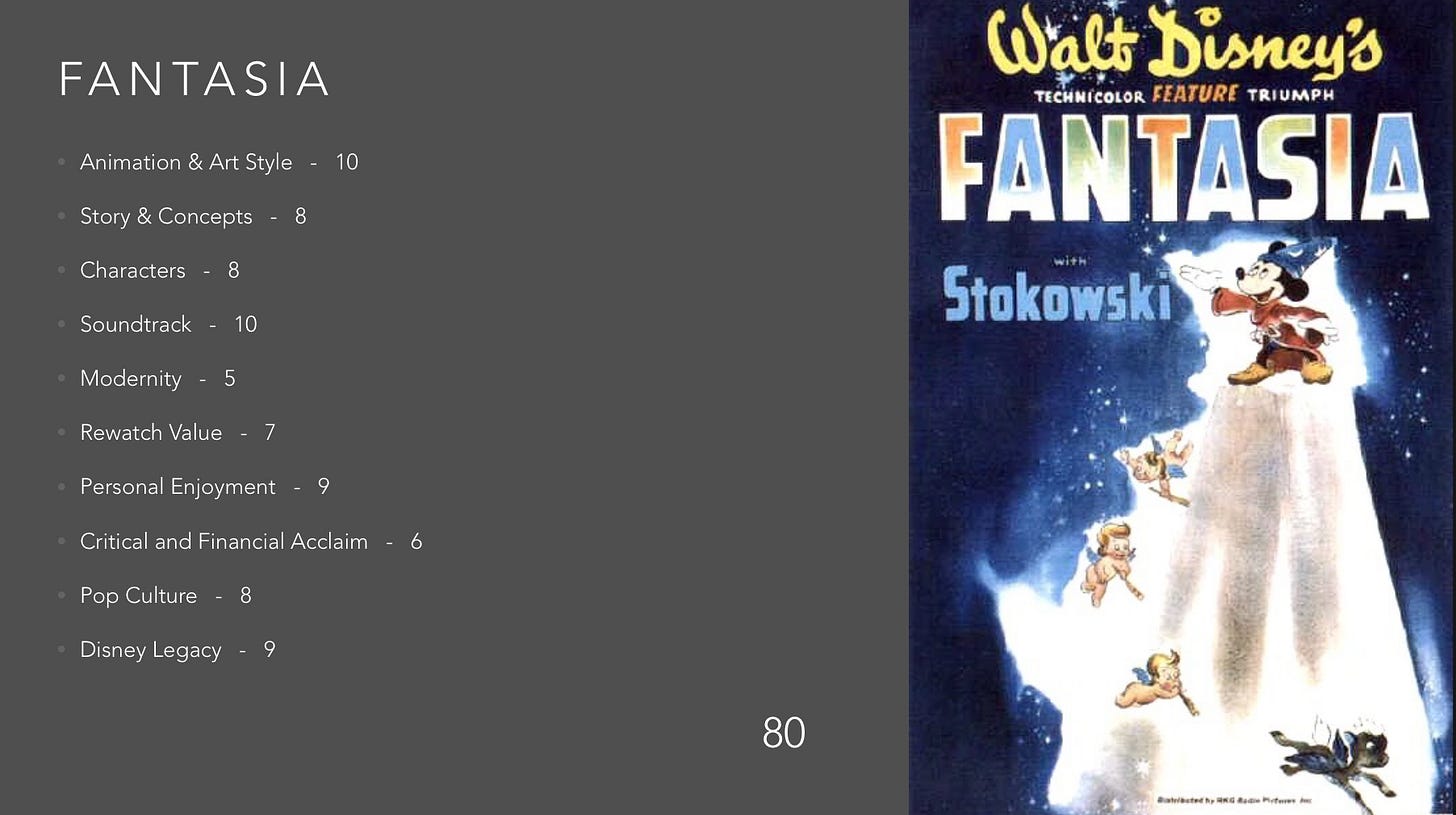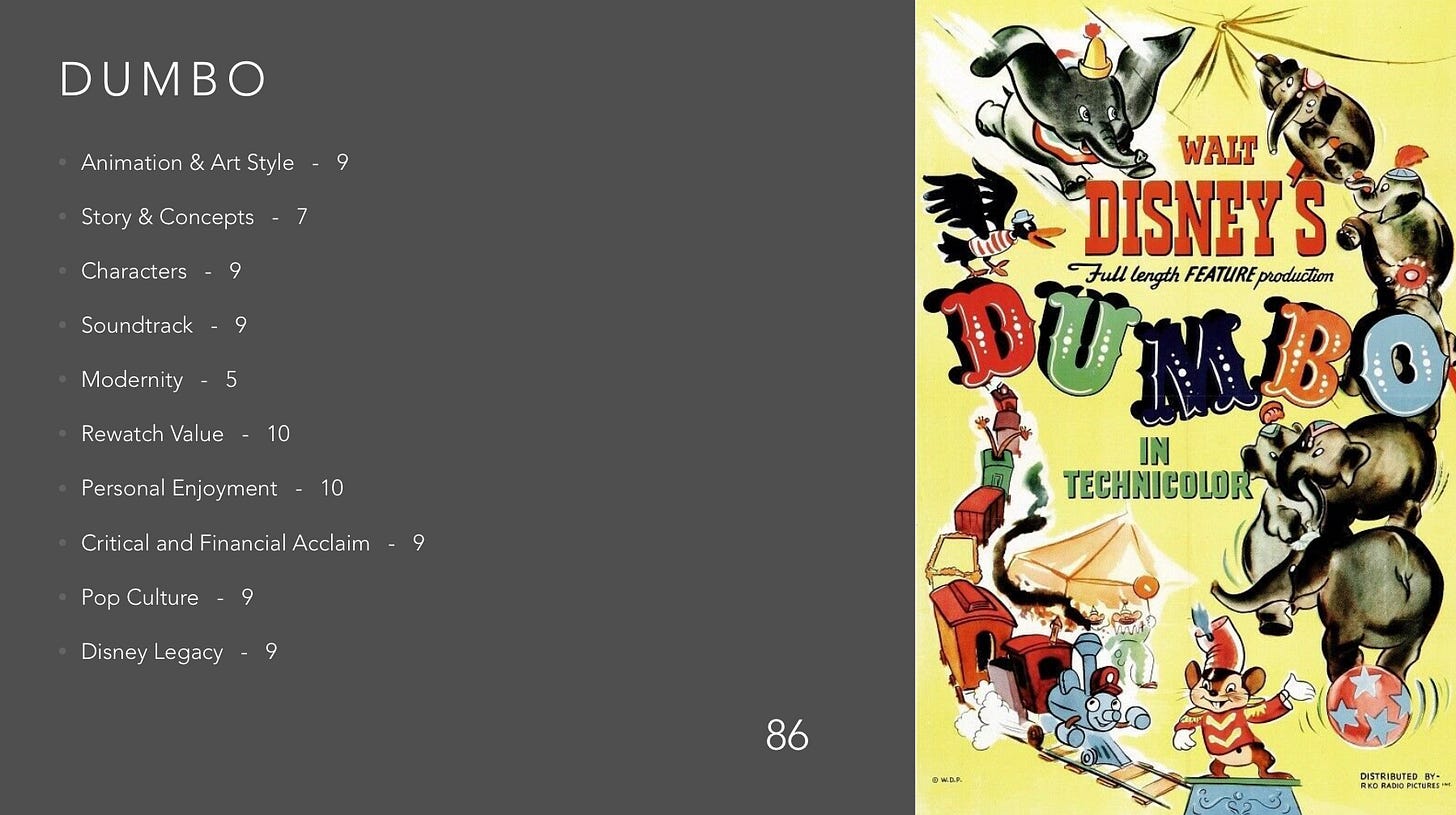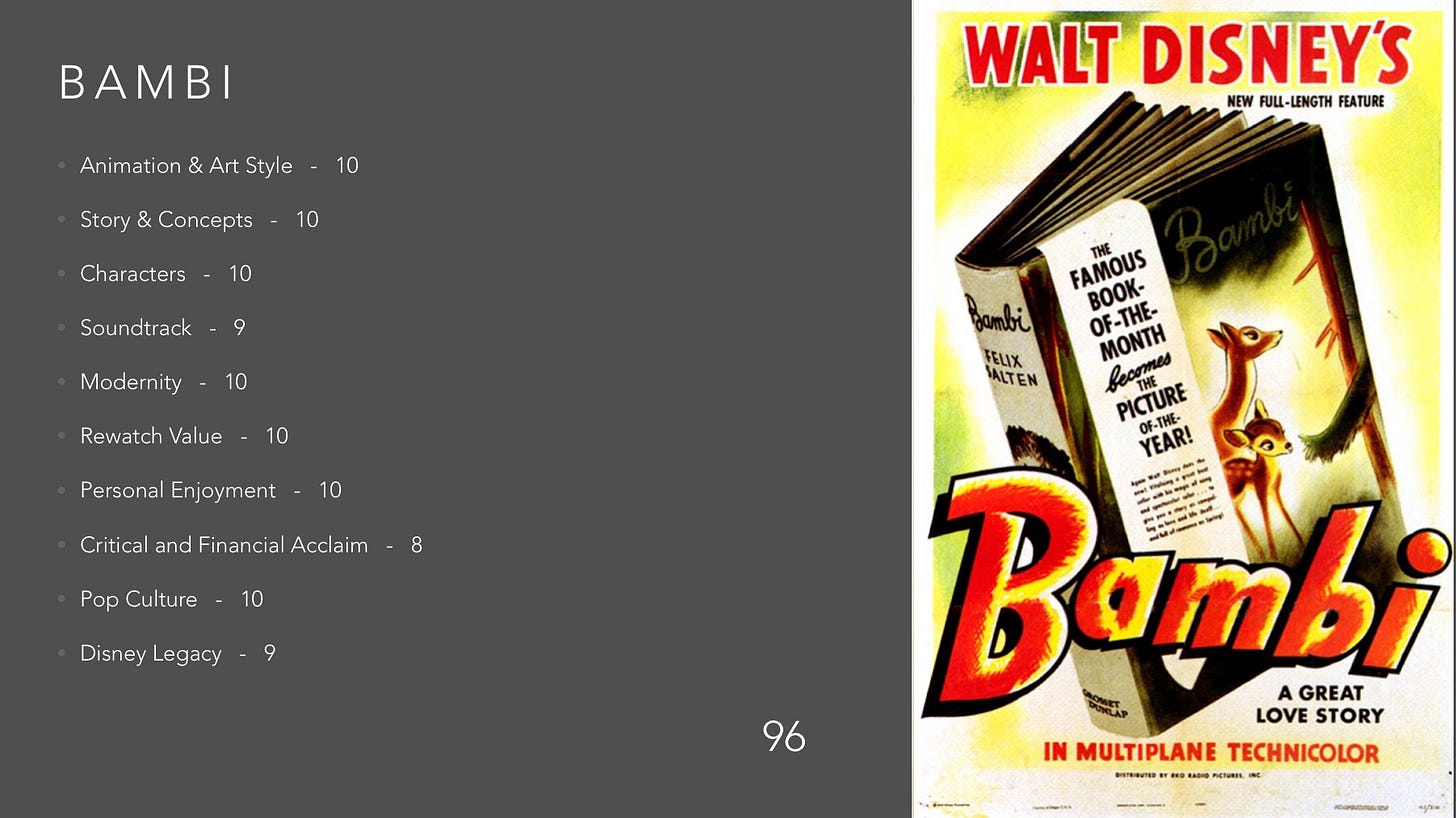The Disney Animated Canon
Welcome to the first Side Vault. I will use these articles to discuss non-video game things that interest me… And one thing that I am a massive fan of is The Walt Disney Company. I love the history, movies, parks, and everything Disney does. Walt Disney is one of my idols, and yes, I acknowledge that he was by no means a perfect person. But his desire to make kids happy and tell stories with animation and parks is something I have always admired about him. I know that makes me a “Disney Adult,” which gets ridiculed in many circles. But I don’t personally think that’s a bad thing. If anything, I’m proud of my Disney fandom.
One aspect of Disney I love is the Disney animated canon, or as I like to call it personally: the Walt Disney Classics line. This is the official line of movies that are numbered and go from Snow White to Strange World. Now a lot of people tend to get confused by this, but these are the animated movies directly from the Walt Disney Animation Studios that Walt himself created. This does not include movies from Pixar or any other animated Disney film outside of the studio. I have seen them all, and I have fond memories as a kid of watching the great movies of the 90s. Heck, even the dreaded Disney Vault is a bit of nostalgia for me.
If you’re not aware, these movies have their eras. They are the Golden Age, the War Era, the Silver Age, the Bronze Age (also known as the Lost or Dark Age), the Disney Renaissance, the Post-Renaissance, the Disney Revival, and the current era, which has yet to get a name. Each era has its flavor and memorable films. And most of the eras represent what the company was going through during those years.
The Disney Golden Age
The Golden Age is the movies made as Walt got the company going and began to use animation to create full motion pictures. By the end of the Golden Age, the Walt Disney Company had become a major pop culture icon in America (despite some financial troubles). These movies revolutionized animation and are highly acclaimed by historians today. With Walt overseeing them and led by his famous “nine old men,” the studio would create magic and movies that are still watched by all generations to this day.
These films have also been called the “tar and sugar era” due to the animated style of using big dramatic emotional scenes, usually right after or in between much more lighthearted and happy ones. Rather than the upbeat personality that Disney is known for today, these movies focused on more serious themes.
I saw all these films as a kid through VHS rentals and when they came on the Disney Channel. Even when I went through my teenage “Disney is for kids” stage, I still had high respect for these; they very much symbolize early Walt Disney. When I sat down to watch these films last year, I watched them for the first time in a long time and was surprised at how well they held up.
What are the Rankings?
So, what are these rankings, and what are they all about? In 2009, CSPAN released their latest Presidents’ rankings after surveying over a hundred historians. As a history fan, I liked the idea they had with separate categories. This got me thinking about doing the same thing, but instead of Presidents… I wanted to do it with the Walt Disney Classics line. I was beginning to rediscover my love for Disney after a decade. That love would only grow when 2012 hit, and I was going to the parks a lot. Unfortunately, even though I got the idea, I never could get it started.
However, that changed when Disney+ launched. Just like that, I had access to the entire Walt Disney canon (well, except for Make Mine Music). The idea popped back into my head, but that’s also the year my daughter was born, so life again delayed those plans. But in 2022, I could finally sit down and start watching these movies. I put together the rankings, and just like that, I was off.
So, before I explain the rankings, I want to reiterate something; this is purely a fun and biased project. Everyone will have a different view on each film, and you might disagree with the ranking I give for each category, but that’s completely okay. This is, first and foremost, something for fun as a Disney fan. If you want to have fun with it, you can steal my idea and try it yourself.
We have ten categories. Each one is scored between 1 to 10. This means the overall total score maxes out at 100. The plan is to combine all the eras when I’m done and create an extensive 60+ list to see which comes out on top. These categories are:
Animation and Art Style – How I feel about the animation and art techniques used.
Story and Concepts – A look at the story, concepts, and any messaging in the film.
Characters – How I view the cast of characters, heroes and villains, as well as memorability.
Soundtrack – The musical score and those famous Disney soundtracks.
Modernity – How well the movies hold up, including their treatment of subjects and cultures.
Rewatch Value – How likely am I to rewatch this film.
Personal Enjoyment – My overall score of the movie if I was reviewing it.
Critical and Financial Acclaim – How well did the movie do with critics and box office success (including re-releases).
Pop Culture – The movie and characters’ attachment to pop culture today.
Disney Legacy – How important is this movie to the overall legacy of the Walt Disney Company.
Total Score – The final total score when adding up all ten categories.
Snow White and the Seven Dwarfs (1937)
Snow White kicked it all off. Put together by Walt in painstaking fashion to prove that animation can make full-length motion pictures with emotion and powerful stories. I first saw this one as a kid, and of course, it’s gone on to be considered a significant film in film history.
The biggest issue with this movie is its modernity. It follows a formula that women aren’t too crazy about these days of a damsel in distress saved by a man, who’s also a Prince that whisks them away to a happily ever after. There is also the subject of the “seven dwarfs” which prominent people in that community, like Peter Dinklage, have criticized. I acknowledge this in the modernity score. It also has a basic plot outline and a lot of filler. The middle of the film is more like an old silly symphonies-type cartoon showing how Snow White and the animals surrounding her help clean and cook. The middle part made me give the movie an 8 for personal enjoyment and rewatch value, as it was too much filler.
However, there is a reason this movie has the legacy it does. The animation is GORGEOUS. This is something that’s a staple of this era. There was attention to detail in every part of the movie, down to the background objects. The soundtrack, despite its age, is memorable and still stands the test of time. And the characters have rightfully gone down in history, especially the great villain of the evil Queen, who sets up the blueprint for future Disney villains. This movie deserves its status and its consequential status, despite its flaws compared to today’s more modern views.
Animation and Art Style - 10
Story and Concepts - 8
Characters - 9
Soundtrack - 9
Modernity - 6
Rewatch Value - 8
Personal Enjoyment - 8
Critical and Financial Acclaim - 10
Pop Culture - 10
Disney Legacy - 10
Final Score - 88
Pinocchio (1940)
The movie that added much to the Walt Disney image and legacy. The company’s anthem, When you Wish Upon a Star, makes its debut here. The overall plot leading to a dream come true would be a staple for the company that still is part of its makeup to this very day.
I remembered this as not a bad movie, but not one I loved when I was younger. However, rewatching this was the first surprise of the marathon I got watching these films. Maybe it’s just being older, or perhaps I paid attention more, but I loved this movie. The themes it plays with are extremely dark when you sit down and think about it, yet it ends in the ultimate finale with a dream come true for the protagonist. The animation is beautiful, and the soundtrack is top-tier Disney. The one thing I would say, the movie does have some filler moments like its predecessor. But it does make up for it; as far as I could tell, still aging well. If anything, its themes are more important today. The characters have gone on, rightfully, to become staples in the Disney mythos, and I can’t help but highly recommend this film. I would even argue its more consequential to the overall legacy and themes that the Walt Disney Company practice today, compared to Snow White.
Animation and Art Style - 10
Story and Concepts - 9
Characters - 10
Soundtrack - 10
Modernity - 10
Rewatch Value - 9
Personal Enjoyment - 9
Critical and Financial Acclaim - 8
Pop Culture - 10
Disney Legacy - 10
Final Score - 95
Fantasia (1940)
The movie that almost sunk the company… Fantasia, is a beautiful mix of animation with classic musical scores, which were made to be seen as a concert-like experience. Furthermore, the movie sets Mickey Mouse as the company’s mascot with the brilliant Sorcerer’s Apprentice segment. Despite almost bankrupting the company, Fantasia has gone on to be seen as a great experiment by Walt.
What I love about this movie is that you can sit back and enjoy it without overthinking. It’s all about mixing great animated sequences with a classic musical orchestra. It has that beautiful Golden Age animation and is filled with memorable moments. Whether it’s the debut of Sorcerer Mickey, the dinosaurs, the dark joy of Nightmare on Bald Mountain with Chernabog, and all the other segments, you’ll come away mesmerized.
That doesn’t mean it doesn’t have its faults. The movie is way too long for my liking, especially since it’s more of a concert than a movie. This affects my rewatch value and makes it hard to put it on, even for background noise. Also, as I mentioned, it almost sunk the company. This movie was so expensive to make that Walt had to cut back on a lot, and it could be argued that it would set up the big strike that showed a little of an uglier side to him and changed how many of his workers saw him. And finally, the original release has some disgusting racist imagery. Disney has cut this part out, but I included it in my modernity score as it was how the movie initially launched. Nevertheless, this is like all of the movies in this era; you have to watch it once in your life.
Animation and Art Style - 10
Story and Concepts - 8
Characters - 8
Soundtrack - 10
Modernity - 5
Rewatch Value - 7
Personal Enjoyment - 9
Critical and Financial Acclaim - 6
Pop Culture - 8
Disney Legacy - 9
Final Score - 80
Dumbo (1941)
My favorite in the era, Dumbo, is a much simpler film but with one of the most important messages told by the company. Released during the worker’s strike and during a financially challenging time, Dumbo was originally going to be a short cartoon that was extended to be the next theatrical film. The character is now known worldwide and is a theme park staple.
As I said, I love this movie, always have. Its simple message is very salient today, teaching that being different is a good thing that can make you better and help you in life. It’s a message Disney carried forward even in today’s fights against the Florida government. Jumbo Jr., yes, that’s his actual name, makes the film as a quiet protagonist, with his friend and unlikely mentor Timothy the mouse doing the talking. Pair it with great music and, once again, fantastic animation, and you got a simple but delightful film.
Now it does suffer from a discussion that always happens when you bring the movie up today – the crows. I like the crows and would argue they’re the only ones that give Jumbo Jr. a chance, but I understand why people have issues with them. They are made as symbols for African American characters and have stereotypical personalities and racist caricatures. It doesn’t help that the leader of the crows was internally known as Jim Crow. And it sucks because, as I said, they help Jumbo Jr. in the end and sing the memorable When I see an Elephant Fly. There’s no doubt that it’s a set of characters that many in the black community can and mostly do find offensive, and that’s why my modernity score for the film went all the way to a 5.
But I want to point out that this movie's overall theme and message, while simple, is significant today. And that’s one aspect of Dumbo that will always age well.
Animation and Art Style - 9
Story and Concepts - 7
Characters - 9
Soundtrack - 9
Modernity - 5
Rewatch Value - 10
Personal Enjoyment - 10
Critical and Financial Acclaim - 9
Pop Culture - 9
Disney Legacy - 9
Final Score - 86
Bambi (1942)
To this day, Bambi is known for having one of the most heartbreaking and emotional scenes in all animated movie history. It’s become so famous that it’s even used in an (in my opinion) eye-rolling way by hunters and jokes. But when you peel back the layer from just that scene, Bambi is a powerful film showing how man affects nature negatively and a coming-of-age story we can all relate to.
The usual staples of the era are here, gorgeous animation, memorable characters, iconic moments, and a very underrated score to boot. But what makes Bambi so great goes beyond that. It’s, in the end, a coming-of-age tale. Bambi is a substitute for a child who grows up and even loses a parent. Then, in the end, he comes out of it a full-grown man ready to take on life. And mixed with that is a message critical of man. Its man that uses fire to burn down the forest, the home of these characters. It’s man that kills this child’s mother, and it’s man that does most of the damage in the movie. The core message stands the test of time. I think of all the era's movies; this one is an absolute must-see and should be preserved for all time. This movie comes close as you can to being perfect storytelling and Disney at its best.
Animation and Art Style - 10
Story and Concepts - 10
Characters - 10
Soundtrack - 9
Modernity - 10
Rewatch Value - 10
Personal Enjoyment - 10
Critical and Financial Acclaim - 8
Pop Culture - 10
Disney Legacy - 9
Final Score - 96
Final Thoughts
The Golden Age of Disney films are some of the most consequential in film history. And, of course, there is no Disney as we know it today without these movies, stories, and characters. I hope you enjoyed this article and hope you look forward to the next one, where I tackled the War Era. The company is forced to survive as World War II breaks out. Walt takes the advice of President Franklin Roosevelt, asking for everyone to do their part, and uses his films to reach out to the Latin American community to prevent them from joining the Axis. This would lead to experimental new animation techniques leading the way to the Silver Age, one of the most critical eras in Walt Disney’s history.
1. Bambi (96)
2. Pinocchio (95)
3. Snow White and the Seven Dwarfs (88)
4. Dumbo (86)
5. Fantasia (80)

